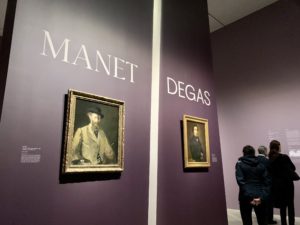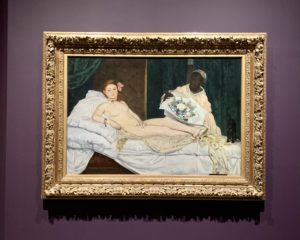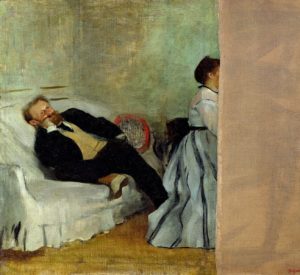On Sunday, September 24th, the Manet/Degas exhibition at the Metropolitan Museum of Art in New York opened to the public. I arrived twelve minutes after the museum opened, and already there was a line out the door extending nearly to 84th Street. The Met understood that the exhibition would draw large crowds, as many of the over 160 works on display are on loan from the Musée d’Orsay and had never been exhibited outside of France, including Manet’s masterwork Olympia. Knowing this, the Met implemented a virtual queue system to handle the crowds. After scanning a QR code and being told it would only take 15 to 20 minutes, I spent some time perusing the Pre-Raphaelite paintings and Rodin sculptures in the gallery just outside. Other individuals like myself, families with small children, and large groups of tourists from Japan or Italy all joined me. After more than an hour, I was finally allowed in.
The exhibition presents the two artists in the classic compare-and-contrast method, which may seem simplistic but very effective. Even when you first walk in, this is plainly evident. The first thing one sees when entering the exhibition are the faces of the two artists, with a pair of self-portraits standing alone beneath each of their names in large letters (see above). On the left, Manet appears in a yellow jacket while holding a brush in one hand and a palette in the other, as if saying, “Look at me, I’m Édouard Manet and I’m ready to paint!” Meanwhile, on the right, Degas appears all in black with a stern look. He has a pen in his hand but holds it away from the viewer as if guarding the instrument of his work. Instead of an excited introduction, his self-portrait says, “Can’t you see I’m working?” This was a rather fitting introduction to the two men. The exhibition frames these two great artists and their work in the context of their professional and personal relationships. Specifically, they tried to focus on the “creative exchanges that punctuated their careers from the time of the meeting”.
Manet/Degas first highlights the similarities between the two men, both the eldest sons of upper-middle-class French families. They were born two years apart, and they abandoned their legal studies in favor of artistic pursuits. The two first met in the Louvre, where Degas was preparing an etching based on a Velázquez painting. But while the two had many similarities in their background, the exhibition also plainly highlights the dichotomies they represent. Manet was personally more expressive and outgoing, an outspoken Republican who frequently commented on contemporary affairs in his work. The American Civil War, the French intervention in Mexico, the Franco-Prussian war, and the Paris Commune all found their way onto Manet’s canvases at one point or another.
Meanwhile, Degas was reserved and conservative. But while this dichotomy seems very apparent in their personal lives, almost the opposite is seen in their artistic output. Though he seemed more like a free-spirit in his personal life, Manet was more traditional in his professional life. People often associate Manet with the Impressionists, but he never publicly exhibited with them. He maintained his faith in the Salon long after many of his colleagues had abandoned it in favor of independent exhibitions. Manet/Degas implies that Manet and his relationship with the Salon influenced Degas and his artistic aspirations. The exhibition curators suggest that Manet’s Olympia likely overshadowed the large history painting Degas had submitted the same year called Scene of War in the Middle Ages. Therefore, the attention Manet received through Salon works like Olympia may have caused Degas to give up on traditional, more accepted forms of painting altogether.
Of course, just because Manet continued submitting works to the Salon does not mean that his works were at all conventional. Both Degas and Manet pursued their own forms of modernism in different ways. Degas leaned more towards abstraction like his other Impressionist colleagues, while Manet broke from tradition, not through his technique but his choice of subjects. Paintings like Olympia, Déjeuner sur l’herbe, and Dead Christ with Angels may not feature the technical experimentation of his Impressionist colleagues, but the subjects he chose shocked the French public just as much as the technique employed by Degas. This difference is best seen when the two artists chose similar subjects. Several rooms of Manet/Degas show how the two both created work that drew from daily life, from the racetrack to boats on the water, families enjoying their leisure time in the public gardens or at the beach, nights at the opera or in the café.
Scholars have gotten a closer view of Degas and Manet’s relationship thanks to mutual friends, mainly other artists, including Berthe Morisot, her sister Edma, and Henri Fantin-Latour. These artists and their families engaged with each other socially and even intertwined at places. Berthe Morisot married Manet’s younger brother Eugène while at the same time exhibiting with the impressionists alongside Degas. Degas also extended a favor by offering Manet’s stepson Léon a job in his family’s business. Yet, at times, the artists’ relationship became somewhat strained. One example featured early on in the exhibit was the story behind Degas’s 1869 double portrait of Manet and his wife Suzanne, intended as a gift for his friend. Degas shows an intimate domestic scene of Manet reclining on the couch while Suzanne plays the piano. Upset at how his wife was portrayed, Manet cut the canvas in two. Degas took the painting back, repairing it with a piece of blank canvas but ended up not recreating the work entirely. Letters between the Morisot sisters and their mother indicate when the two artists repaired their relationship by mentioning that they were now hosting each other again.
Manet died at 51 due to complications from rheumatism, syphilis, and a gangrene infection. Degas became one of the most prominent figures who spearheaded efforts to help commemorate his life and work. He and Claude Monet petitioned the French government to buy Olympia. He strove to preserve his friend’s memory by acquiring many of his works. Towards the end of his life, Degas owned as many as eighty Manet works, including paintings, drawings, and prints. He even went so far as to recover and reassemble the damaged fragments of one of Manet’s largest, most ambitious works, The Execution of Maximilian, which was on display at the exhibition on loan from London’s National Gallery.
The Manet/Degas exhibition at the Met is not the first time anyone has examined dialogues between artists. Oftentimes, these dialogues occur over great lengths of time and space, like the artistic dialogues between Claude Monet and Joan Mitchell, or between Édouard Manet and Diego Velázquez. But this is one of the first times that these two artists, great friends, and occasional rivals, have been studied together in a curated exhibition setting. Manet/Degas will be running through the first week of January and might be one of the most stimulating and popular museum shows of the year.



